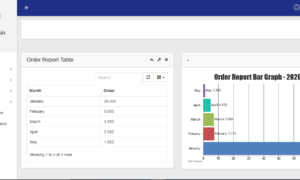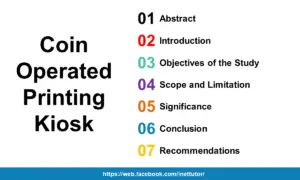K-12 Grading System Review of Related Literature
This project cited books, articles and related systems, which are relevant to the present study. It is composed of related literature and studies, both local and foreign, which contain facts and information significant on the design and development of the new system.
Development Tools:
The project entitled K-12 Grading System is available in the following programming languages:
- Visual Basic and MS Access
- Visual Basic and MySQL
- C# and MySQL
- PHP, MySQL and Bootstrap

REVIEW OF RELATED LITERATURE
Advantages of Automated Systems
An automated system is any system where an input is provided and a machine or computer carries out a process that produces an output. Advantages of Automated Systems include the following: Speed – They can process information much more quickly than humans. This means they are good for controlling machinery that might need to be adjusted instantly; Repetition – Automated systems can do the same task over and over again without getting bored, needing breaks or making mistakes; Accuracy – They can do very detailed work and follow precise instructions without error; Safety – Automated systems can work in places where it would be unsafe to put a human, for example, in a nuclear power plant, under water or in space; Efficiency – They get more done than humans but cost less to operate. This is because the do need breaks, wages, holidays, canteens, heating and lighting. The quality of the work done is always of the same standard being materials are not wasted due to human error; and Adaptability – Automated systems can be reprogrammed to do different tasks. For example, a robot that was used to make one type of car could be reprogrammed to work with a new model or be used to spray paint a car instead of being used to weld parts together.
(http://www.gordonschools.aberdeenshire.sch.uk/Departments/Computing)
Grading (Education)
Grading in education is the process of applying standardized measurements of varying levels of achievement in a course.
Grades can be assigned in letters (for example A, B, C, D, E or F), as a range (for example 1 to 6), as a percentage of a total number correct, as a number out of a possible total (for example out of 20 or 100), or as descriptors (excellent, great, satisfactory, needs improvement). In some countries, all grades from all current classes are averaged to create a grade point average (GPA) for the marking period. The GPA is calculated by taking the number of grade points a student earned in a given period of time divided by the total number of credits taken. The GPA can be used by potential employers or educational institutions to assess and compare applicants. A Cumulative Grade Point Average is a calculation of the average of all of a student’s grades for all courses completed so far. (http://en.wikipedia.org)
Student Profiling System
Student Academic profiling system (SAPS) is a method where the academic and extra-curricular performance of each and every student in school will be stored in a central computer server system over a period of time and a unique Identification number for each student will be used to have the record of each and every student in a computer server. (eMaharashtra, 2013)
Student Records is a section within Information Services and Systems (ISS) responsible for the student database records and administration which are a central part of the core administration function. Increased interoperability and integration of student record systems with other systems such as, timetabling and assessment play a vital role in delivering effective academic and administrative services. (http://www.swansea.ac.uk)
Grading System in the Philippines
Grading in education is the process of applying standardized measurements of varying levels of achievement in a course. Grades can be assigned in letters (for example A, B, C, D, E or F), as a range (for example 1 to 6), as a percentage of a total number correct, as a number out of a possible total (for example out of 20 or 100), or as descriptors (excellent, great, satisfactory, needs improvement).
(http://en.wikipedia.org)
The abovementioned concept is used as basis by the researchers in the formulation of the objectives of the study and serves as guide on what features to be integrated in the system. Furthermore, the concepts presented will also serve as the bases of the researchers in the design of the Grading and Profiling System to address the needs of the administrators, teachers and students.
Grading System of k-12 Program of Department of Education
The assessment process is holistic, with emphasis on the formative or developmental purpose of quality assuring student learning. It is also standards-based as it seeks to ensure that teachers will teach to the standards and students will aim to meet or even to exceed the standards. The students’ attainment of standards in terms of content and performances therefore, a critical evidence of learning.
The assessment shall be done at four levels and shall be weighted as follows:
The levels are defined as follows:
- ““Knowledge” refers to the substantive content of the curriculum, the facts and information that the students acquires.
- ““Process” refers to cognitive operations that the student performs on facts and information for the purpose of constructing meanings and understandings.
- ““Understandings” refers to enduring big ideas, principles and generalizations inherent to the discipline, which may be assessed using facets of understanding.
| Level of Assessment | Percentage Weight |
| Knowledge | 15% |
| Process or Skills | 25% |
| Understanding(s) | 30% |
| Products/Performances | 30% |
| Total | 100% |
- ““Products/Performances” refers to real-life application of understanding as evidenced by the student’s performance of authentic tasks.
Levels of Proficiency
At the end of the quarter, the performance of students shall be described in the report card, based on the following levels of proficiency:
- Beginning – The student at this level struggles with his/her understanding; prerequisite and fundamental knowledge and or skills have not been acquired or developed adequately to aid understanding.
- Developing – The student at this level possesses the minimum knowledge and skills and core understandings, but needs help throughout the performance of authentic tasks.
- Approaching Proficiency – The student at this level has developed the fundamental knowledge and skills and core understandings and with little guidance from the teacher and/or with some assistance from peers, can transfer these understandings through authentic performance tasks.
- Proficient – The student at this level has developed the fundamental knowledge and skills and core understandings, and can transfer them independently through authentic performance tasks.
- Advanced – The student at this level exceeds the core requirements in terms of knowledge, skills and understandings, and can transfer them automatically and flexibly through authentic performance tasks.
| Level of Proficiency | Equivalent Numerical Value |
| Beginning | 74% and below |
| Developing | 75 – 79% |
| Approaching Proficiency | 80 – 84% |
| Proficient | 85 – 89% |
| Advanced | 90% and above |
The level of proficiency at which the student if performing shall be based on a numerical value which is arrived at after summing up the results of the student’s performance on the various levels of assessment. The numerical values are as follows:
What shall appear in the report card is not the numerical value, but the equivalent level of proficiency, abbreviated as follows:
B for Beginning;
D for Developing;
AP for Approaching Proficiency;
P for Proficient; and
A for Advanced
At the end of the four quarters, the Final Grade for each learning area shall be reported as the average of the four quarterly ratings, expressed in terms of the levels of proficiency. The general average shall be the average of the final grades of the different learning areas, also expressed in terms of levels of proficiency with the numerical equivalent in parenthesis.
REVIEW OF RELATED STUDY
Student Information Systems (SIS)
According to Baseler (2011) a Student Information Systems, commonly referred to as SIS, was released initially in 2005 in a collaborated effort between Student Academic Affairs Office (SAAO) and the Office of Educational technology (OET). The objective was to take Banner Student information and create a more user friendly interface for tracking student information, reporting on the information, and further assisting with College of Education needs which could not be met by Banner. In the spring of 2006, SAAO created the Technical Information Specialist position to improve response time to SIS developmental needs as well as to assist users and create new modules and reports. As of May 2007, SIS is being used by the entire SAAO staff, Graduate Department Support Staff, and a group of 18 faculty members.
(https://education.illinois.edu/saao/documents/SIS_Manual.pdf)
Benefits of a Well-Designed Automated Student Record System
According to nces.ed.gov (2010) the advantages of a Well-Design automated Record System are the following: Cost saving and cost avoidance- A well-conceived and implemented automated student record system can reduce the costs of handling the paperwork associated with record keeping; Quicker Response- allows for timely retrieval of needed information; Accuracy- is vital at every stage, from data collection, to entry, to maintenance in the system it provides users with the confidence they will require to rely upon a student record system; Getting the needed information- they can provide the information required on request, easily, and without burdensome trial-and-error searching; Moving data among different education agencies- allows for the easy and efficient movement of student records among levels of the education system using standard formats.
This studies presented above by Baseler and nces.ed.gov have significance to the researcher’s study because the study of Baseler is similar to the present study that is to create a more user friendly interface for tracking student information, reporting on the information, and generate accurate reports.
Credits to the authors and developers of the project and study.
You may visit our Facebook page for more information, inquiries, and comments. Please subscribe also to our YouTube Channel to receive free capstone projects resources and computer programming tutorials.
Hire our team to do the project.


